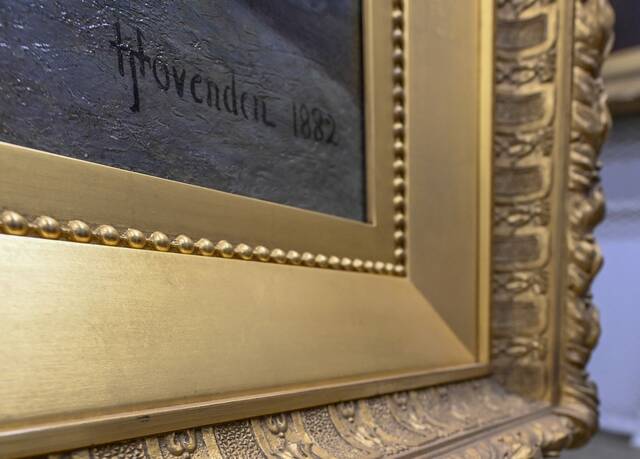Behind the art: The Westmoreland's 'Death of Elaine' beloved of staff and visitors
A scene of mourning at Camelot, the castle of the legendary King Arthur, is depicted in Thomas Hovenden’s 1882 oil painting, “Death of Elaine.”
The king and his queen, Guinevere, along with knights, ladies-in-waiting and servants, are gathered around a bed holding the body of the young noblewoman, Elaine.
Hovenden took his inspiration from “Idylls of the King,” a cycle of 12 narrative poems retelling the Arthurian legend by the English poet Alfred, Lord Tennyson.
The painting was a 1985 gift to The Westmoreland Museum of American Art by the Mary Marchand Woods Memorial Fund.
“Elaine has passed from a broken heart,” said Doug Evans, the Greensburg museum’s director of collections and exhibition management.
The knight Lancelot was hurt in a joust and Elaine helped nurse him back to health, Evans explained.
“She’s a young girl and she falls in love with this older knight, but he doesn’t reciprocate,” Evans said. “He’s actually in love with the queen.”
A deaf-mute servant sitting near the head of Elaine’s bed knows what has transpired, and King Arthur is holding a letter from Elaine that will reveal the truth when he reads it.
The figure of Elaine is illuminated, but Hovenden otherwise emphasizes the solemnity of the scene with muted colors and shadows.
“It’s a prime example of the artist’s work,” Evans said. “This is a very special piece to me also, because of its importance to our visitors. It’s just a beautiful scene and our visitors and docents have always enjoyed it.”
In the past, when “Death of Elaine” has been on exhibit, the museum has provided costumes that children could don to re-enact the scene, and high school students have created poetry related to it, he said.
The painting was recently re-framed and will go back on exhibition Oct. 16.
Working partnership
“Death of Elaine” came to The Westmoreland in what Evans called “an unsympathetic gallery frame.” It was too narrow and did nothing to enhance the work, he said.
The new frame was made by Gill & Lagodich Gallery in New York City, which specializes in custom-made frames and restoration of historical frames. At 7¼ inches wide, it is more proportional in scale to the 46-by-71-inch painting.
The frame’s decorative elements include laurel and berry detail on outermost edge, a belleflower interior and then a flat bevel with strand of pearls. Some elements are burnished and some have a flat finish.
“The light changes across the burnished and duller sections,” Evans said. “As you move to view the painting, the light travels across the frame and gives illumination to the piece.
“The light from the frame reflects into the piece and enhances the overall effect. The frame and the painting are a partnership working together,” he said.
Thomas Hovenden’s work is important in the canon of American art, Evans said, because his is “a perfect story of a young person who immigrates to the United States and is able to work hard and become successful.”
Hovenden was born in Ireland in 1840 and orphaned as a child when his parents died during the potato famine. He apprenticed with a woodcarver and gilder and studied at the School of Design in Cork.
At 23, he immigrated to New York City, where he supported himself by coloring photographs and making frames. Following a move to Baltimore, Hovenden met the prominent art collector William T. Walters, who encouraged him to study painting in Paris. In France, he also spent time at an American art colony in Brittany.
When he returned to New York, his interior paintings of everyday life brought him success and popularity. In 1881, he married the artist Helen Corson and they moved to her father’s homestead in Plymouth Meeting, near Philadelphia.
“He enjoyed success, although it was a short career,” Evans said. “He saved a child from being hit by an oncoming train and was himself killed (in 1895).”
“Death of Elaine” is a “beautiful narrative story, and the painting is impressive and well-loved,” Evans said. “To me, because (Hovenden) was also a frame maker, not to have a complementary, sympathetic frame was rather harsh.
“Now I think he’s going to be beautifully presented.”
Shirley McMarlin is a Tribune-Review staff writer. You can contact Shirley by email at smcmarlin@triblive.com or via Twitter .
Remove the ads from your TribLIVE reading experience but still support the journalists who create the content with TribLIVE Ad-Free.


